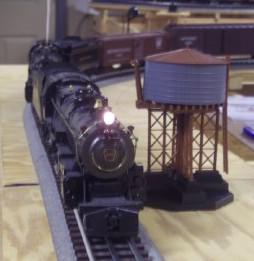When two or more locomotives are lashed up together, this increases the amount of horse power. True enough, but it is the tractive effort that needs to be examined. Take my favorite locomotive, the AC6000 by GE. She is, perhaps the quintessential example of brute power. Both in scale and in the real world. She can out pull just about anything out there. Yet, in scale and in reality, even she has her limitations. She must pull, not only her own weight, but also the weight of how ever many cars are lashed up to her. This is where the tractive effort comes in. She must also get things moving and that requires huge amounts of tractive effort.
By lashing up two and typically three locomotives together, the tractive effort is increased greatly. This not only helps in a smooth start, but also assures that the locomotives themselves will actually help each other out.
I am not using numbers here for simplicity, but when three AC6000's are lashed up together, nothing on heaven and earth will stop them from moving the gargantuan load(S) behind them. Obviously, each locomotive has its own power curve. Thus, the engineer and freight conductor must configure the whole affair so that there is not only enough horse power, but tractive effort available when the time comes to push the throttle.
One of the reasons Union Pacific designed and built the DD40AX locomotive was because of the lack of any real high horse power locomotive out there back in the 60's. Mating essentially two of the same locomotives together meant massive power for one locomotive. Lashing two of these beast together meant that UP could move far more freight/loads then any other rail service.
Today, everything is about "green" locomotives. Less pollution and greater pulling effort, but with a smaller more up scaled type configuration. GE has led the way with this technology by employing some rather specific principles to modern railroading. One being that a locomotive need not be huge to move allot of freight. Two being that a locomotive need not use a diesel engine which puts out massive amounts of pollution. Lastly, railroads need locomotives that are capable of going great distances on the least amount of fuel possible. Thus saving all involved allot of money. Lashing up three ES44AC's or two SD90's can accomplish allot with less fuel.
In scale, the reason I believe we use this, is primarily for looks. Yes, the theory holds that even in scale, two or three AC6000's or what ever you are using on your layout, when they are lashed up together, they can pull tremendous amounts of cars all around the layout until you decide to pull power on them.
Pete
![]()






